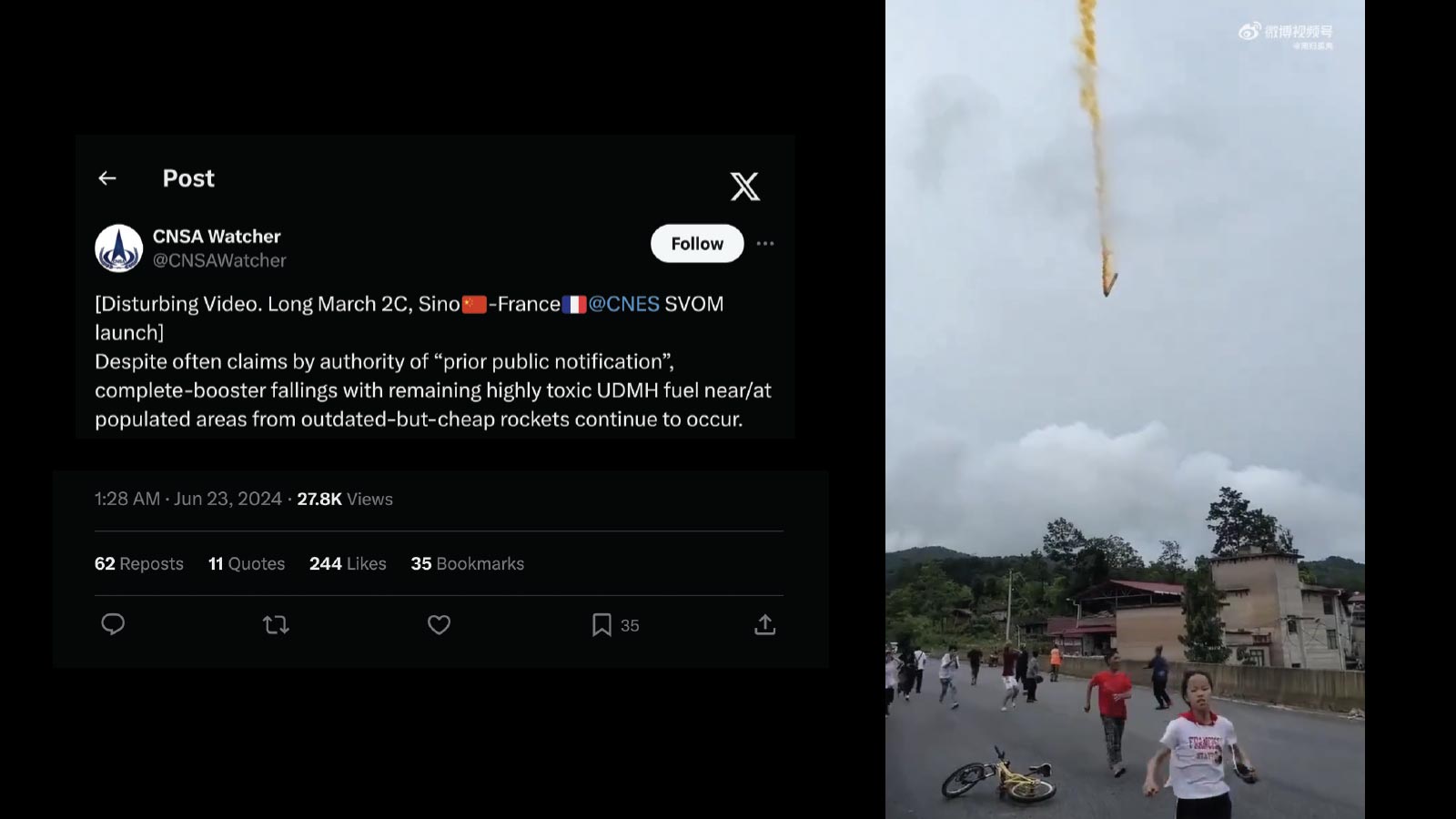Stay Up to Date
Submit your email address to receive the latest industry and Aerospace America news.
The rocket part seen spewing orange vapor as it fell near a Chinese village in June was a spectacle that’s unlikely to ever occur in the West for two reasons.
First, launch vehicles made by Western companies do not lift off with thrust provided by the dangerous propellants whose presence was signaled by the orange fumes. A Chinese document confirms that the Long March 2C first stage likely seen in the video was powered by such propellants, and the first and second stages of Russia’s Proton rockets are powered that way too. Likewise, India’s Geosynchronous and Polar Satellite Launch Vehicles also make use of the propellants, and North Korea reportedly used them for its three satellite launch attempts in 2023, one of which it claimed as a success.
These vehicles mix hydrazine fuel and nitrogen tetroxide oxidizer to create a spontaneous, or hypergolic, combustion reaction. There is no need for ignition, which is one reason the combination is attractive. The downside is that hydrazine is highly toxic.
For that reason, the rest of the world prefers liquid oxygen and hydrogen fuel, and sometimes fossil fuels, namely methane or kerosene. Hypergolic propellants are reserved for operations in space, where smaller amounts fuel thrusters that steer satellites and space capsules, including Boeing’s Starliner and SpaceX’s Crew Dragons. For launches, even more extreme precautions would need to be taken because of the larger quantities required. The cost of doing that has made the combination unattractive to U.S. companies, says William Anderson, a professor of aeronautics and astronautics at Purdue University in Indiana.
Then there is the matter of geography. The Long March 2C lifted off from China’s Xichang Satellite Launch Center located 1,200 kilometers from the nearest coast. The vehicle ascended over rugged terrain dotted with villages, including Xianqiao, where the apparent first stage was captured on video plunging earthward. No injuries were reported, according to news accounts.
The video went viral online and was shown on cable news, while the rocket’s payload — the Space-based multi-band astronomical Variable Objects Monitor, a Chinese-French telescope — arrived in orbit safely, according to the China Aerospace Science and Technology Corp., which launches the Long Marches.
As for the footage: “The orange fumes are probably from the nitrogen tetroxide,” says Anderson. In that case, unburned hydrazine may have been present too, and it may have been just luck that no one was injured.
U.S. experiments with rodents in the early 1960s showed hydrazine to be carcinogenic, and testing on dogs resulted in “vomiting, tremors, convulsions, and death,” according to a 1963 report. So, not surprisingly, when an unoccupied Boeing Starliner capsule landed in the Utah desert in 2019 and another in 2022, video showed employees approaching the vehicles in full hazmat suits to inspect each capsule for hydrazine leaks.
Associate editor Cat Hofacker contributed research to this report.
About paul brinkmann
Paul covers advanced air mobility, space launches and more for our website and the quarterly magazine. Paul joined us in 2022 and is based near Kennedy Space Center in Florida. He previously covered aerospace for United Press International and the Orlando Sentinel.
Related Posts
Stay Up to Date
Submit your email address to receive the latest industry and Aerospace America news.




